Introduction
There used to be only a handful of sports optics manufacturers that had laser rangefinding binoculars in their offer. This is no longer the case – the competition is getting fiercer by the day, which is why we have decided to prepare a buying guide in this field. The purpose of it is to narrow down the possibilities and point out the best buys in each of the listed price classes.
If you have any additional questions regarding laser rangefinding binoculars or any optical device from the field of sport optics, send an e-mail at info@optics-trade.eu. As a team of passionate sports optics enthusiasts, we are always glad to help.
History
A laser rangefinder is a device that determines the distance to the observed object with a laser beam. The emitted light reflects from the observed surface and travels back to the sensor on the rangefinder – the distance is calculated based on the time elapsed between emission and reception (speed of light). The first system of this sort was developed in the early 1960s. It was not long until such systems were used by the military.
In the early 1980s, Simrad Optronics from Norway implemented a laser system into a handheld binocular – the first-ever laser rangefinding binoculars named LP7 were introduced.
The first laser rangefinding binoculars for the civilian market were introduced in 1992 when engineers at Leica managed to integrate a laser system considered eye-safe (class I) in their binoculars. These binoculars, called Geovid, revolutionized the industry – before that, only the military could benefit from this technology. The first Geovid 7×42 measured distances up to 1000 m. Up to this day, the introduction of the first laser rangefinding binoculars for the civilian market remains one of the biggest achievements by Leica and one of the greatest milestones in the history of sports optics.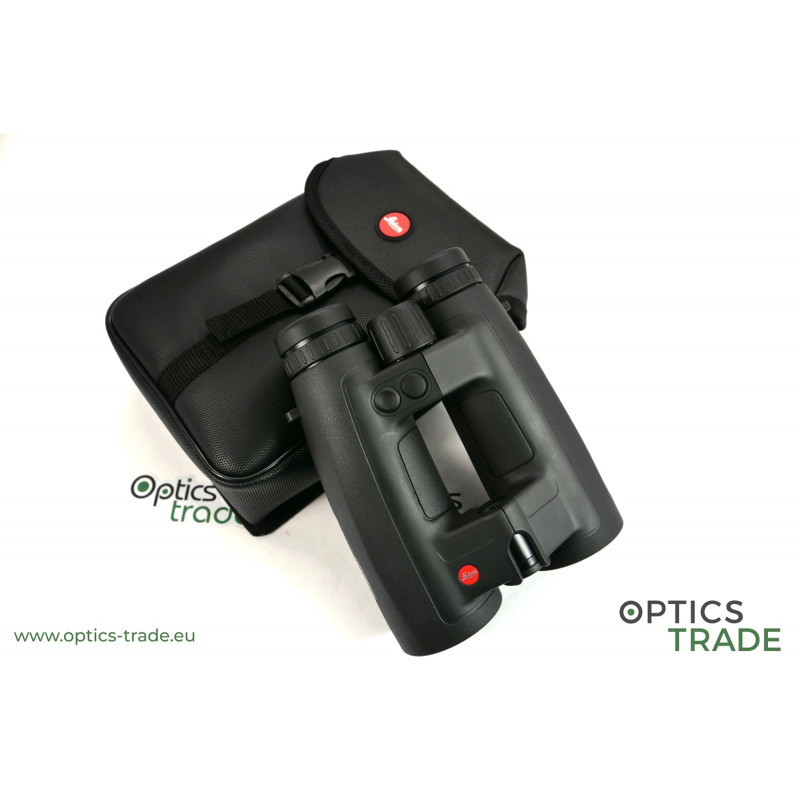
Leica Geovid 8×56 3200.COM
The evolution of technologies in LRF-binoculars
In the beginning, the laser rangefinding binoculars provided the linear distanceonly. This is the distance from the device to the observed object. Manufacturers refer to this type of reading differently – line-of-sight distance, actual distance, etc. Gradually, the manufacturers of these devices added new features to their products.
They were soon able to display the angle, so that the user could calculate the horizontal component of the distance which is important when calculating proper bullet drop compensation. With time, the LRF-devices were able to calculate the mentioned component with the help of software. At roughly the same time, modes such as rain (fog) mode, scan mode, best target mode and last target mode were introduced. The manufacturers equipped their best LRF-devices with a ballistic calculator. The data was transferred to the device with a MicroSD card. Only a few years ago, Bluetooth connectivity was introduced. The best devices can now be connected to a smartphone with an installed app (transferring the data has never been easier). All the mentioned features and some other ones are described in the section below.

Features found on LRF-binoculars
Scan mode
Many of the features are referred to as modes. One of them is Scan mode. Ranging is always done with a press of a certain button in laser rangefinding binoculars. With devices that feature Scan mode, the user can hold the button down for the device to continuously update the distance to the observed object. The mode is especially useful when observing a moving target. Some modern devices (2020) provide up to four distance measurement updates in a second when using the ‘Scan mode’. https://www.youtube.com/embed/KtJh8k5uHAU?version=3&rel=1&showsearch=0&showinfo=1&iv_load_policy=1&fs=1&hl=en-GB&autohide=2&wmode=transparent
Best and Last target modes
Many modern laser rangefinding binoculars are equipped with Best Target and Last Target modes. When the user clicks the ranging button, the device emits a series of laser beams towards the target. Rangefinders that feature both of these modes are typically set to Best Target mode by standard. This means that they provide the distance to the object that delivers the most results (an average value). This is the most versatile mode with accurate results in most circumstances. Last Target mode, on the other hand, provides the user with the distance to the farthest object that the laser reflects from. This mode is extremely useful when we observe an object hidden behind bushes and branches. https://www.youtube.com/embed/i1Ct_GYvfUY?version=3&rel=1&showsearch=0&showinfo=1&iv_load_policy=1&fs=1&hl=en-GB&autohide=2&wmode=transparent
Rain (fog) mode
Some devices come with a Rain (fog) mode. Using a laser rangefinding device in rain, fog, and snowfall has always been problematic. The particles in the air cause the laser to disperse after emission, delivering inaccurate results. This mode is designed to counter this effect, but it is important to note that it is no match for adverse weather conditions (heavy rain, fog, or snowfall).
There is some other terminology associated with LRF-binoculars that should be pointed out.
Linear distance measurement
All laser rangefinding devices are equipped with their basic function, and that is linear distance measurement, often referred to as line-of-sight (LOS) measurement. This is the distance from the device to the observed object.
Equivalent horizontal range
Some laser rangefinders calculate the equivalent horizontal range (EHR), which is the horizontal component of the distance. In flat terrain, this feature is not of much use. In hilly terrain, where the observed object is located up- or downwards, the linear distance and its equivalent horizontal range can differ greatly, especially when the distance to the observed object is great. This is especially useful for hunters who hunt in the mountains because the horizontal component of the distance is crucial when calculating the proper bullet drop compensation. The computer calculates the distance with the help of linear distance and the measurement angle. Some more affordable models provide only the linear distance and the angle (the user must calculate the EHR on his or her own).
Ballistic computer
Advanced LRF-binoculars come with a ballistic computer – the user can input the ballistic data of the ammunition used. The computer then calculates the correction needed. Usually, the device gives the correction in form of a holdover or click adjustment. In older devices, the data was transferred to the device via a microSD card. The best and most modern devices feature Bluetooth connectivity – the information is transferred to the device through the smartphone application.
Atmospheric factors
Some LRF-devices consider the atmospheric factors (air temperature, air pressure, humidity, etc.) when calculating the ballistic data. These factors influence the air density which plays an important role in bullet drop (the bullet does not travel well through dense air). The lower the temperature the denser the air is, resulting in a quicker bullet drop. The higher the air pressure the denser the air is, resulting in a quicker bullet drop. And finally, the lower the humidity the denser the air is, resulting in a quicker bullet drop. This basically means that the bullet will experience more resistance in arid places with low temperature and high air pressure.
Laser classification
Most laser rangefinding binoculars designed for the civilian market use a class 1 eye-safe IR laser. Nevertheless, direct eye contact with the emitter should always be avoided. Laser rangefinders, designed for the military, usually exceed class 2 energy levels.
Fields of use
Many can benefit from the laser rangefinding technology, not only the military. Ranging is useful in:
- hunting
- sports shooting
- forestry
- civil engineering
- golf
- archery, etc.
In most trades, a laser rangefinding monocular is the preferred choice because of its compactness, but that does not apply to hunting.
A laser rangefinder is commonly used in two types of hunting: mountain stalking and long-range hunting, where the distances to the observed animal are longer. The bullet drop is significant when shooting at a longer range, and the only way to calculate the drop at a certain range is to know the exact distance. In mountain hunting (and elsewhere where the terrain is hilly), where the shots are often considerably inclined, the horizontal component of the distance is a crucial piece of information.
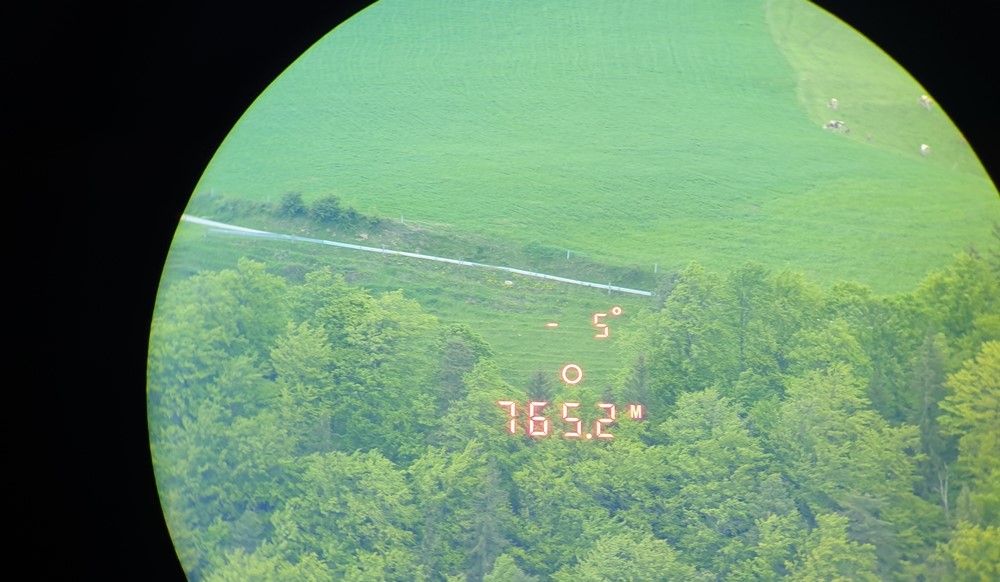
Hunting should be ethical – hunters do not shoot at an animal 2 kilometres away as it is impossible to be 100% accurate at such a distance. The bullet might graze the animal, inflicting agonizing pain. Most hunting rangefinders thus do not provide an equivalent horizontal range and bullet drop compensation at distances beyond 1000 m (none of them can guarantee 100 % accuracy at this distance, and this helps prevent such situations).
Here, it is important to explain the advantage of LRF-binoculars that take into account the atmospheric factors when providing the user with the correction. Let us say you are hunting at around 500 m of elevation above sea level in an arid landscape, using a laser rangefinder that is capable of including the atmospheric data when providing you with the ballistic information. When you measure the distance to the game, you are told to dial 5 clicks to the elevation turret. Next week, you are at the same elevation but in a humid environment. Even though the distance to the game is the same, you are told to dial 3 clicks to the elevation turret. Why is that? This is because the atmospheric factors vary – in humid environments, the air is thinner. Air pressure and temperature also affect the density of the air. Rangefinders that consider all of these when providing the user with bullet drop are significantly more accurate than those which do not.
Some sports shooters use a laser rangefinder to find out the distances to the targets before the start of the competition. They are also popular among tactical sport shooters.
LRF-binoculars vs Standard binoculars and an LRF-monocular for hunting purposes
Binoculars are among the key hunting equipment. With them, the observed animals can be spotted and identified. As hunting often requires some physical strain, carrying as few pieces of equipment as possible is always welcome. For this reason, many hunters prefer having LRF-binoculars instead of standard binoculars and an LRF-monocular. The weight is reduced, it takes up a lesser portion of space, and having two devices in one is handy per se. Furthermore, two important hunting processes can be carried out with a single device – identification and ranging. Observing with both eyes is much more comfortable, and the eyepiece on a monocular is much narrower than the ones in binoculars, further affecting the comfort of use. Monoculars’ image quality is at a lower level, and it is difficult to use it in the dusk because of the small objective lens (the beam of light that passes through the device is very narrow).
Leica Rangemaster 2800.COM
Nevertheless, combining standard binoculars with an LRF-monocular does have some advantages. Because we want to be completely honest during this article, we will point them out. One of the advantages is the price. The combination mentioned above is often cheaper than LRF-binoculars. If we compare standard binoculars and LRF-binoculars of the same price class, standard binoculars are brighter in the dusk because the laser system integrated into one of the barrels of the LRF-binoculars impairs the light transmission, often resulting in some kind of a tint. Only the best LRF-binoculars out there do not have a notable tint of some colour in one of the barrels. Furthermore, standard binoculars of the same price class as LRF binoculars offer sharper images, more vivid colours, wider field of views, and fewer optical errors.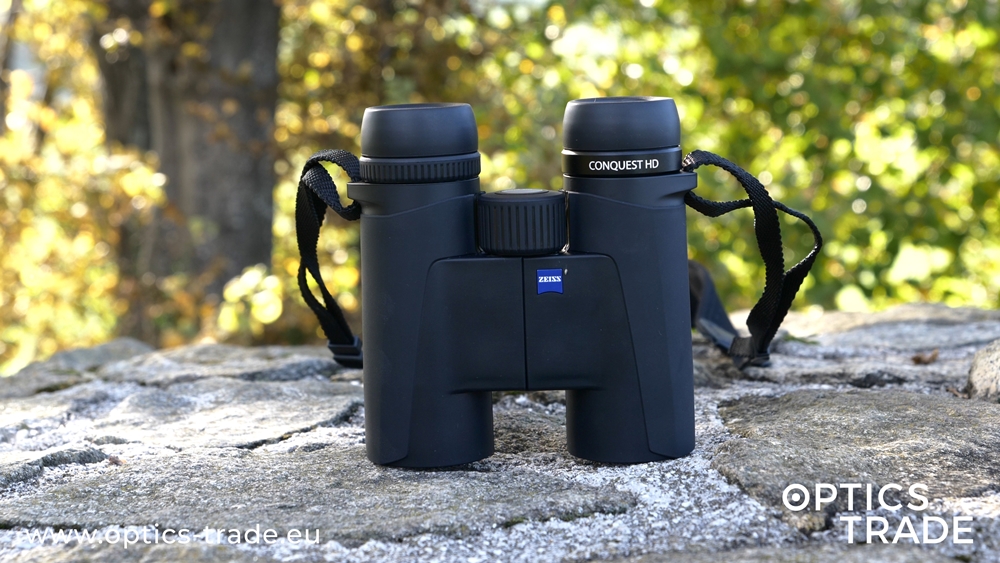
Zeiss Conquest HD binoculars (without a laser rangefinder)
Price classes
0–1000 €
Until not long ago, no LRF-binoculars had been available for a price under 1000 €. Even the models manufactured in China usually carry a higher price tag (around 1500 €). Currently (October 2020), there are only a few optics manufacturers that offer binoculars with a laser rangefinder under 1000 €. We anticipate that more manufacturers, especially those who make most of their products in China, will shortly come out with competitive products. Because we have only been able to acquire Sightmark Solitude, we will apply its characteristics to the whole price class.
First, we must point out that there are two versions available, a model that only measures the linear distance and the one that also provides the user with the equivalent horizontal distance and height calculation. They cost 790 € and 930 €, respectively. We are intrigued by the sheer fact that they are available for such an affordable price. Solitude is, as expected, made in China but much cheaper than most of the devices from the same category made there. The body of the binoculars is rubberized for protection and to provide a firm grip. It comes with a single bridge with a long fold. The maximum measuring distance is 1200 m. Optically, these are not as advanced as the more expensive binoculars in this category. Still, they provide a decent image quality for the price. Inside, there are roof prisms of the Schmidt-Pechan type, and the interior is purged with dry nitrogen to prevent internal fogging at low temperatures. Their biggest downside is that they have a fixed focus. The part that appears to be a focusing knob is actually the battery compartment. The eyepieces are somewhat crude and do not hold their position well. Not the most elegant binoculars out there. The display is in the right barrel; the bottom part where the readings are displayed is yellowish, and the line that separates this part from the rest of the image obstructs some field of vision.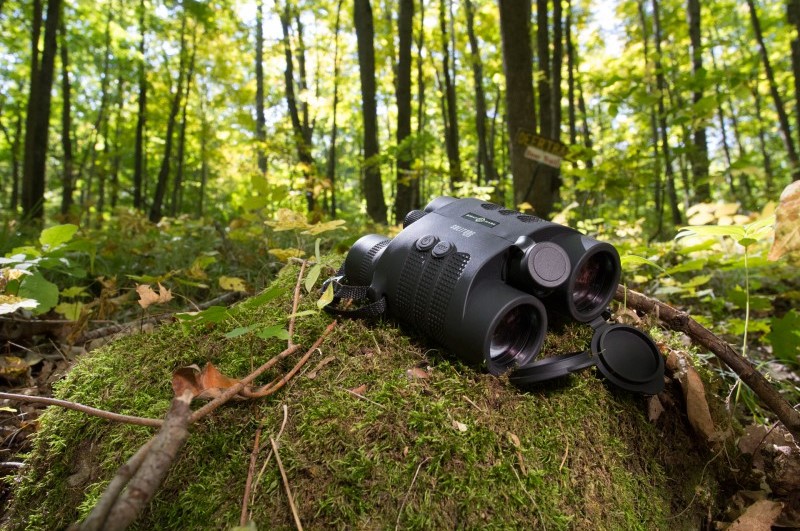
Source: Sightmark
Pros
- Affordable
- The more expensive version (which is still affordable) can calculate EHR (Equivalent Horizontal Range)
Cons
- Fixed focus
- the bottom part of the image seen through the right barrel is yellowish (and a black line covers some field of vision)
- not the most elegant
- low-quality eyecups
1000–2000 €
In this price class, there is a wider range of choice. It is important to point out that up to around 1500 €, the devices are of Chinese origin, whereas those nearing the 2000 € price point are made in Europe. All the devices here provide the user with the equivalent horizontal range, a feature that comes in handy when making an inclined shot. Some advanced features such as Best target mode, last target mode, and scan mode are present (certain manufacturers refer to these modes with a different term). The prisms are of the Schmidt-Pechan type, and several devices are quite bulky, featuring a bulb at the bottom of each of the barrels (mostly those made in China). Even though some of these devices boast a maximum detection range of around 4500 m, they are only capable of measuring such distances in optimal conditions and when aimed at highly reflective objects. Most of them (in reality) measure distances up to 2000 m. Only a few models in this price class are equipped with a ballistic computer, allowing the user to transfer the ballistic data of the used ammunition to the binoculars. The warranty is mostly 10 years on the material and 3–5 years on the electronics.
Best buys
These binoculars are the only ones (to our knowledge) that offer an advanced ballistic computer at a price point of around 1500 €. While the competitive devices provide the user with EHR (Equivalent Horizontal Range) exclusively, Kilo3000BDX can be connected to a smartphone app where the user can input the ballistic data of the used ammunition. When the data is transferred to the binoculars, the software calculates the bullet drop compensation that is necessary, either in the form of a holdover or a number of clicks (up to around 700 m). The smartphone app is intuitive to use. We are also fond of the device’s Scan mode which operates swiftly, providing four readings in a second. You can choose from Best or Last mode in the menu. As it operates on Sig Sauer’s BDX technology, you can even pair it with a BDX riflescope (the info on bullet drop compensation is transferred from the binoculars to the riflescope after the measurement). Last but not least, the binoculars can be paired with a Kestrel that runs on AB-elite software. When paired, KILO3000BDX can provide a ballistic drop compensation for as far as the binoculars can range, which is up to around 2500 m) Sig Sauer is known for the unique looks of their devices and KILO3000BDX is no exception. The optical quality is identical to all other Chinese-made LRF-binoculars in this price class – nothing extraordinary. There is a bulb at the bottom of each barrel, adding to the bulkiness. Currently, it is only available in one configuration – 10×42. https://www.youtube.com/embed/HEbyQd0AucU?version=3&rel=1&showsearch=0&showinfo=1&iv_load_policy=1&fs=1&hl=en-GB&autohide=2&wmode=transparent
Pros
- EHR calculation
- Advanced ballistic computer (holdover or number of clicks) – amazing for this price
- Intuitive smartphone app (can be connected to binoculars via Bluetooth)
- In Scan mode, the readings are updated four times in a second
- Unique exterior
- can be connected to a Kestrel with AB-Elite Software
Cons
- a bulb at the bottom of each barrel
- nothing special optically
- available in one configuration only
Geovid R series has been around since 2005. Even though it has received a couple of upgrades throughout the years, they still feature the classic design. The last version of the R series was released in 2016 – this is when the EHR (Equivalent Horizontal Range) function was added. Geovid R is Leica’s most affordable series of LRF-binoculars. Even though these are not as optically advanced as Geovid HD-R and .COM models nor do they feature Leica’s best coatings, they provide the best optical quality in the price class just below 2000 €. They are also among the few binoculars in this price class that are made in Europe (Portugal). Four models are available: 8×42, 10×42, 8×56, and 15×56; not many manufacturers offer a laser rangefinding binocular with a 15x magnification. A great choice for someone who wants great optical quality in an LRF-binocular and does not need advanced features such as a ballistic computer. https://www.youtube.com/embed/oNZNSP66Bn8?version=3&rel=1&showsearch=0&showinfo=1&iv_load_policy=1&fs=1&hl=en-GB&autohide=2&wmode=transparent
Pros
- great optical quality for the price
- EHR calculation
- Available in four configurations
- Made in Europe and priced below 2000 €
Cons
- Outdated, classic design (even though some are fond of it)
- No ballistics calculator
It is difficult to match the elegance of GPO Rangeguide. These unique, all-black binoculars boast a magnesium housing. One can tell that the workmanship is on a high level by inspecting the details on the surface. There are no bulbs on the barrels and the rangefinder software is hidden well within the chassis. Optically, the device delivers – the user is provided with sharp images, full of vivid colours. In Scan mode, 3 readings per second are displayed. To match the display brightness with ambient lighting as accurately as possible, 9 brightness settings are at disposal. Rangeguide can calculate the equivalent horizontal range but is not equipped with an advanced ballistics calculator. It comes in elegant packaging, with a quality transport case. Currently, only the 10×50 version is available – it is advantageous in light transmission capabilities over most LRF binoculars in this price class that are only available in a 10×42 configuration.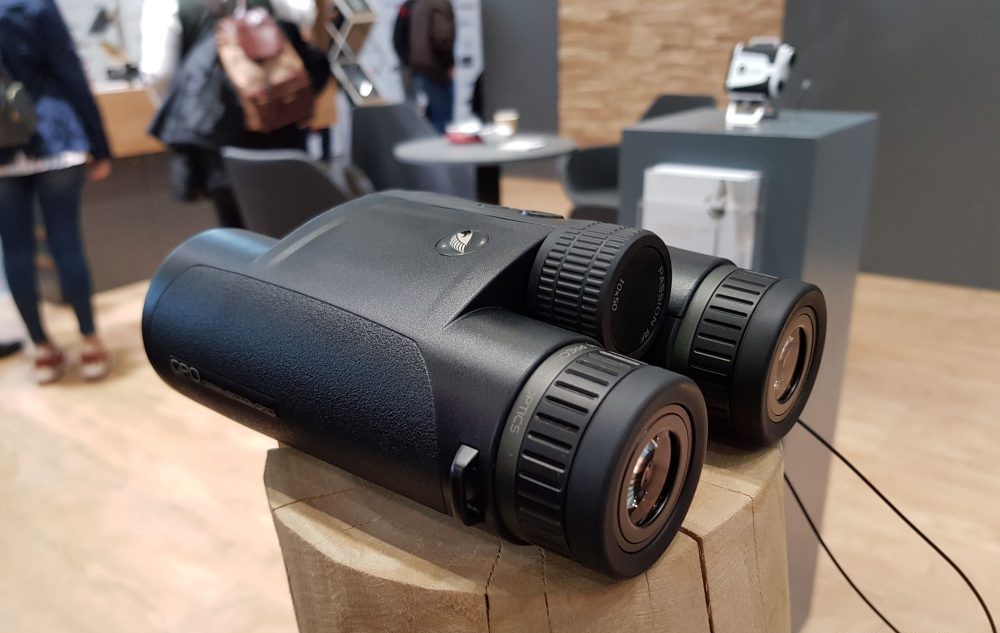
GPO Rangeguide 10×50
Pros
- Magnesium housing
- High level of workmanship for the price
- No bulbs on the barrels
- EHR calculation
Cons
- Available in one configuration only
- No ballistics calculator
2000 € +
All binoculars in this price class are made in Europe. Only the most renowned European sports optics manufacturers have the knowledge to assemble laser rangefinding of such high quality (Swarovski, Zeiss, Leica, Meopta). They all provide the user with the horizontal component of the linear distance. Those priced above 2500 € are equipped with a ballistic computer, and the user can transfer the ballistic information onto the binoculars through a smartphone app via Bluetooth (on older models, the data is transferred to the binoculars with a MicroSD card). Furthermore, the binoculars take into account atmospheric conditions when providing the user with correction (air pressure, temperature). Such binoculars have all the advanced modes (Scan mode, Best Target mode, Last Target mode). Many are equipped with an open bridge design and all come with multiple eyecup-positions, allowing for an optimal eye relief setting. The housing is made of magnesium, and the surface is covered in quality rubber. Some of them have unique prisms inside (Leica Geovid – Perger-Porro, Zeiss Victory RF – Abbe-Koenig, etc.). The best can measure distances up to 3000 m. Up to 10 years of warranty is provided on the material, while the electronics are covered for 3–5 years in general. You can rest assured that getting one of these is a long-term purchase. As they hold their resale value well, you can count on selling them for a fair amount of money, even after a decade.
Best Buys
Swarovski EL-Range with Tracking Assistant(Update 2021)
In 2021, Swarovski finally presented their first LRF-binoculars with an advanced ballistics calculator. The third generation of the famous EL-range series brings along several software improvements including a function called Tracking Assistant which helps the hunter find the harvested animal. It works with the help of a digital compass, and you can use it with or without a smartphone – to learn more about this intriguing function, watch our video review on the new EL-Range. The new models are compatible with a user-friendly smartphone app that is incredibly easy to navigate. The user can create three ballistic profiles. Once the ballistic profile is chosen and the ballistic data transferred to the binoculars, the new EL-Range will provide you with correction when the distance to the observed object is measured (in MOA, MIL, or even in clicks if a Swarovski riflescope is chosen in the app). It also measures the EHR (Equivalent Horizontal Range) just like the previous generation. To make the use of these functions easier, Swarovski added a button at the bottom part of the left barrel. The third generation of EL-Range does not bring software improvements only, optical upgrades have also been introduced. These are the first Swarovski LRF-binoculars to feature the Swarovision technology, a field-flattening lens system that gives the user an impression as if he or she was inside the image while observing. The field of view has been increased by 10 % compared to the previous generation. The user can increase image stability by mounting a forehead rest which acts as an additional point of compact with the user’s face. This accessory, available for an extra 129 €, is especially useful to have when observing for longer periods of time or while fatigued. Currently (2021), these are the most advanced LRF-binoculars on the civilian market but also the most expensive. It is a pity that Swarovski still has not ditched the bulbs at the bottom of the barrels like its competitors in the premium class.![]()
Swarovski EL-Range with Tracking Assistant
Pros
- Great optical quality (no tint in any of the barrels)
- Swarovision technology (field-flattening lens system)
- EHR calculation
- Advanced ballistic calculator
- Magnesium housing
- Open-bridge construction
- Quality multi-position eyecups
- Tracking assistant function
- Forehead rest compatibility
- An amazing field of view
Cons
- Expensive
- Bulbs at the bottom of the barrels
- No low-light models with a bigger lens diameter
It is next to impossible to talk about best buys in this price range and skip Leica. Geovid is a famous name – the first model was introduced in 1992 and set an important milestone in the world of optics as those were the first laser rangefinding binoculars for the civilian market. The series is still around, and the models from the .COM subseries are more advanced than ever. If you purchase one of these, you get the latest technologies currently available in this field. Not only can it calculate EHR (Equivalent Horizontal Range), it can provide the user with bullet drop compensation according to the ballistic data of the used ammunition (you can search for the ammo that you are using in the database or insert its characteristics yourself). The user can input the data into the smartphone app and then transfer it to the binoculars via Bluetooth. Then, after all the important parameters are set, the user can choose in what format the correction is provided, holdover or number of clicks. On top of that, it takes the atmospheric factors (air pressure, air temperature) into account when providing the correction. Technology aside, the 3200.COM is a great binocular per se. It has magnesium housing, quality multi-position eyecups, and open bridge construction. Leica’s latest, most advanced coatings are applied to the lenses to provide an image of topmost quality. Furthermore, unique prisms, called Perger-Porro are used to further enhance the experience. No tint can be observed in any of the barrels. There are three models available: 8×42, 10×42, and 8×56. Sure, all the models in this series are expensive but also packed with features. All Geovid models are made in Portugal.

Leica Geovid 3200.COM
Pros
- Great optical quality (Advanced coatings and Perger-Porro prisms)
- EHR calculation
- Advanced ballistic computer (holdover or number of clicks)
- Can be connected to a smartphone app via Bluetooth
- Magnesium housing
- Quality multi-position eyecups
- Open-bridge construction
- No bulbs on the housing
- No tint in any of the barrels
Cons
- Expensive
Out of all the laser rangefinding binoculars of the highest quality class, Victory RF sports the most elegant look. It is almost impossible to tell that a laser compartment and the accompanying software are hidden within these binoculars – the only indicator are the two buttons, one on each of the barrels. They come in Zeiss’s signature black colour. Even though they look like standard binoculars, they boast one of the most advanced LRF technologies on the market. No tint can be observed when looking through either barrel. Zeiss was the first out of the great three (Swarovski, Leica, Zeiss) to launch laser rangefinding binoculars that the user could connect with a smartphone app via Bluetooth (this was only possible with a MicroSD card before that). Once the ammunition data is inserted into the app, you can transfer it to the binoculars with a single click. You can then select whether you want the correction displayed in the form of a holdover or number of clicks. Victory RF also takes the air pressure and air temperature into account when providing bullet drop compensation. These Germany-made binoculars do not sport an open bridge configuration; nevertheless, you can use them single-handedly thanks to the location of the focusing knob (it is closer to the centre of the binoculars in comparison to the competitive products). The body is made of magnesium. The quality eyecups can be set to many positions for an optimal eye relief setting. Zeiss uses the best coatings at disposal to enhance the image quality and user experience (T*, LotuTec®). To further enhance the brightness of the image, Abbe-Koenig prisms are used. Four models are available: 8×42, 10×42, 8×54, and 10×54. They are waterproof and withstand extreme temperatures all the way down to − 30°C. https://www.youtube.com/embed/981vmUP8bDA?version=3&rel=1&showsearch=0&showinfo=1&iv_load_policy=1&fs=1&hl=en-GB&autohide=2&wmode=transparent
Pros
- Great optical quality (Advanced coatings and Abbe-Koenig prisms)
- Elegant design
- Looks like a standard binocular
- Advanced ballistic computer (holdover or number of clicks)
- Can be connected to a smartphone app via Bluetooth
- Available in four configurations
- Magnesium body
- No tint in any of the barrels
Cons
- Expensive
Notable mention
Even though Geovid HD-R series is not equipped with a ballistic computer and Bluetooth connectivity as its bigger brother .COM, it excels in all other aspects. The optical quality is at the same level as with .COM models – although there is a laser system in one of the barrels (as is the case with all other LRF-binoculars in the civilian market), the image quality and the light transmission rate are not compromised, which we can attribute to Leica’s advanced coatings and the Perger-Porro prism system used. When looking through the barrel with the sensor (the laser is located between the barrels), no tint can be observed, which is outstanding. Even the external parts of the lenses are coated with the hydrophobic coating AquaDura which repels water and dust. HD-R provides the user with EHR (Equivalent Horizontal Range) calculation and Scan mode. The binoculars can display the air pressure and air temperature readings but as the device is incapable of providing correction, these values are not used in any of the calculations. There are three models available: 8×42, 10×42 and 8×56, all made in Portugal. All of them measure distances up to 2500 m which is far enough. HD-R offers a great deal of optical quality for the price. Consider checking this series out if you search for top-notch optical quality and do not require an advanced ballistic calculator. https://www.youtube.com/embed/lhvEeB_g100?version=3&rel=1&showsearch=0&showinfo=1&iv_load_policy=1&fs=1&hl=en-GB&autohide=2&wmode=transparent
Pros
- Great optical quality (Advanced coatings and Perger-Porro prisms)
- EHR calculation
- Magnesium housing
- Quality multi-position eyecups
- Open-bridge construction
- No bulbs on the housing
- No tint in any of the barrels
Cons
- No ballistic computer (most binoculars priced 200–300 € more already have it)
Conclusion
LRF-binoculars are designed with the hunter’s requirements in mind. With them, you can both identify an animal and measure the distance to it. in situations where both these processes are mandatory, you thus rid yourself of one extra piece of equipment. Before making a purchase, you have to decide what functions are of crucial importance to you and make a decision based on that. Remember, if you encounter any dilemmas, do not hesitate to contact us via e-mail (info@optics-trade.eu). Helping the customers decide is a cornerstone of our company.
Past best-buys
Here, the best buys from the previous years are listed. They have either been replaced with a new-generation model or pushed out of the ‘best buys’ section by a more competitive product.
2000 €+
Swarovski EL-Range (2nd generation)– removed from the ‘best buys’ section in 2021
The second-generation EL-Range model was replaced in the ‘best buys’ section by the much more advanced third-generation EL-Range model which hit the market in 2021. This was the accompanying text:
We cannot go past Swarovski when referring to the highest quality class of optics. EL-Range features Swarovski’s best coatings: Swarodur, Swarotop, and Swarobright. Even though it is a laser rangefinding binocular, no tint can be observed in any of the barrels. The image is sharp, bright, high in contrast, and full of vivid colours. The light transmission is equal for both barrels, which is a result of excellent Swarovski workmanship. The horizontal component of the linear distance can be calculated; Swarovski refers to the technology used as Swaroaim. There are no field-flattener lenses inside like in the standard EL. The brightness of the display can be set to 5 levels or automatic. If the latter is turned on, the brightness is automatically adjusted according to the ambient light. Sadly, EL-Range is not equipped with a ballistic computer nor does Swarovski offer a model that would have it (this changed in 2021, EL-Range TA has this function). The body is made of magnesium, and the binoculars feature an open bridge configuration, allowing for simple use with one hand. The surface is dressed in quality rubber, ensuring a good grip, and providing additional protection against impacts. The eyecups are of high quality and can be set to many positions. Swarovski’s strap attachment solution is one of the best and simplest on the market. There is a bulb at the bottom of each of the barrels. An orange version of these binoculars, referred to as EL O-Range, is also available. Each of the versions is available in two configurations: 8×42 and 10×42. The binoculars are made in Austria.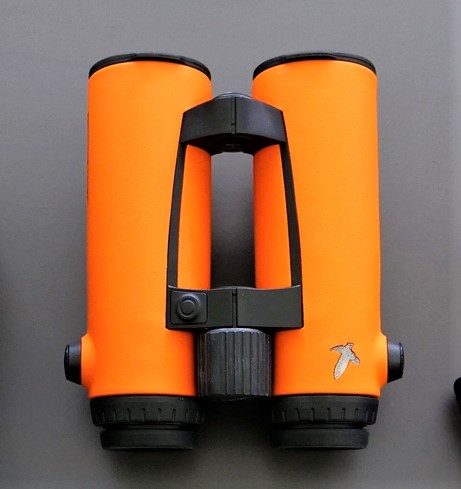
Swarovski EL O-Range
Pros
- Great optical quality
- Magnesium body
- Open bridge construction
- No tint in any of the barrels
- A great, simple solution for the attachment of the strap
Cons
- No ballistic computer
- Expensive
- Bulbs at the bottom of the barrels
- No low-light model (56 mm lens) available
Source and author: Andraž Gradišnik, www.optics-trade.eu





